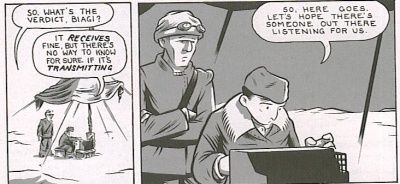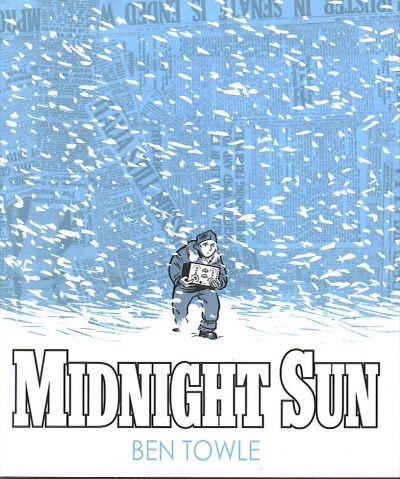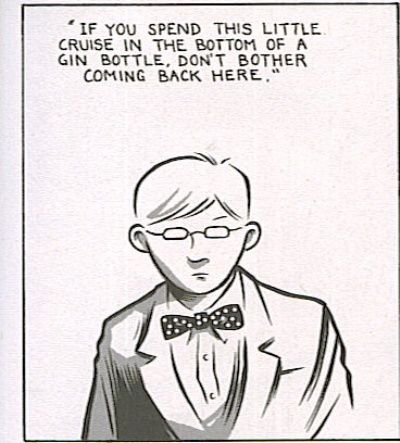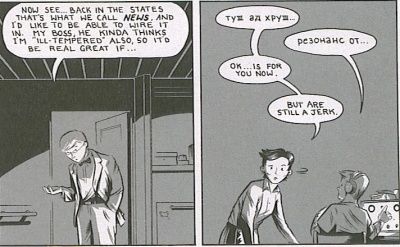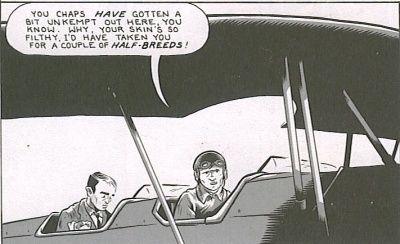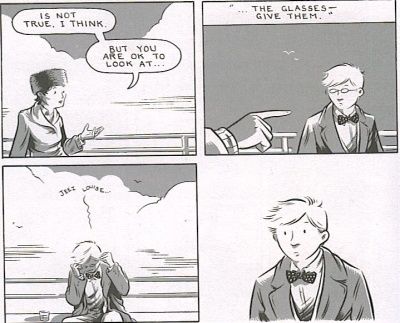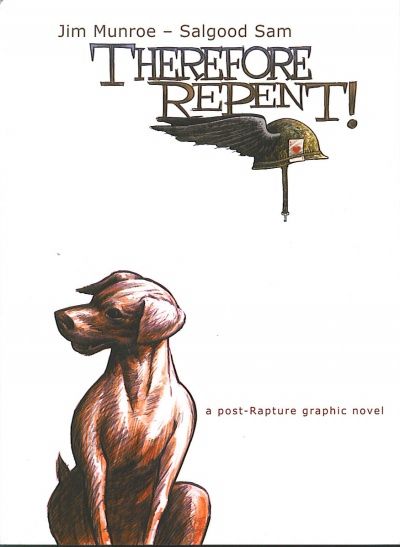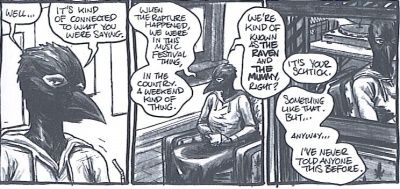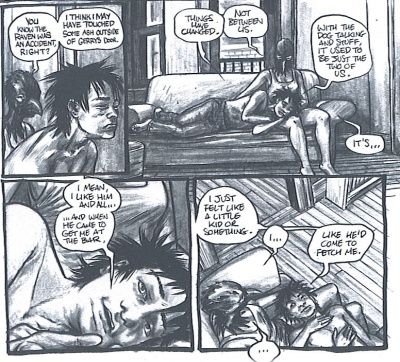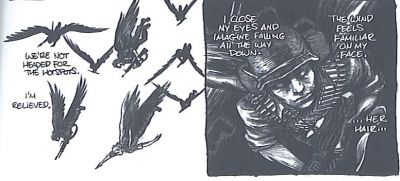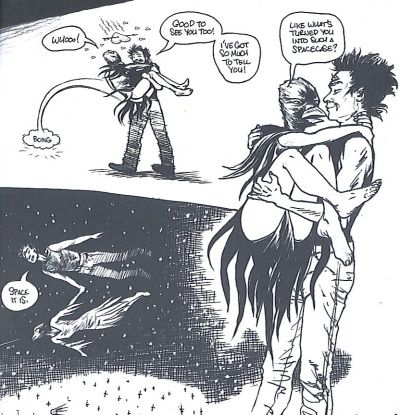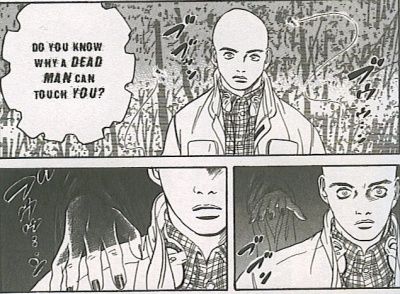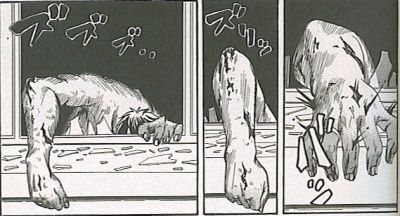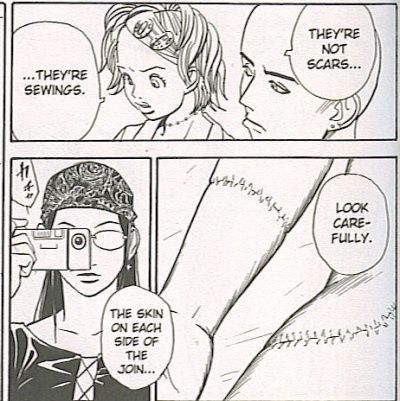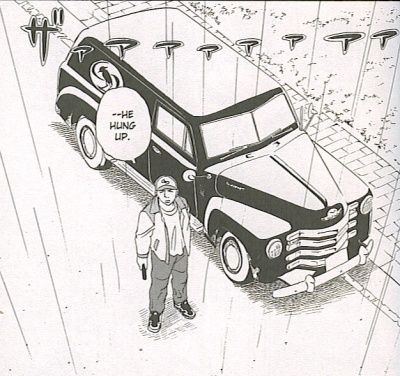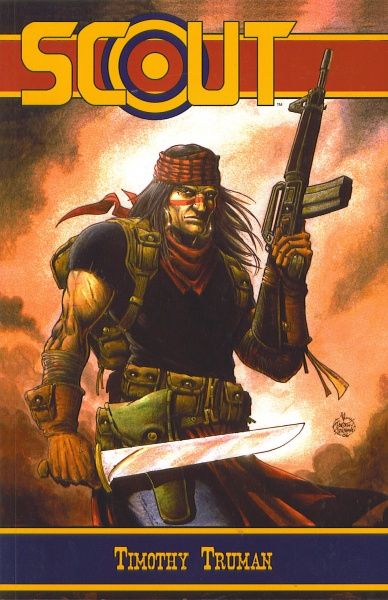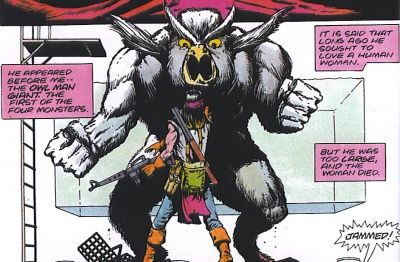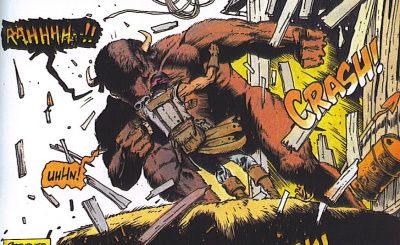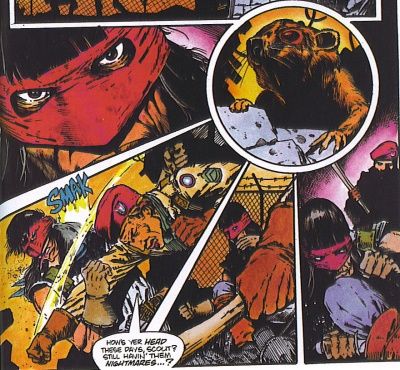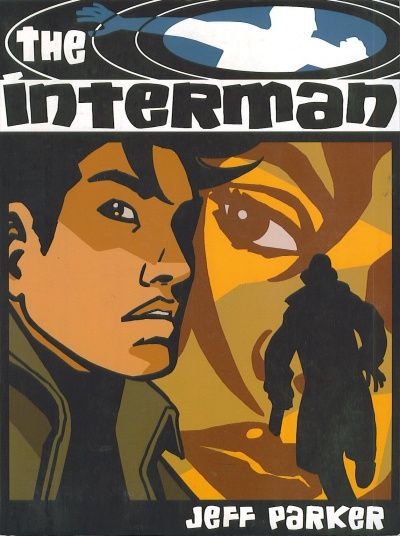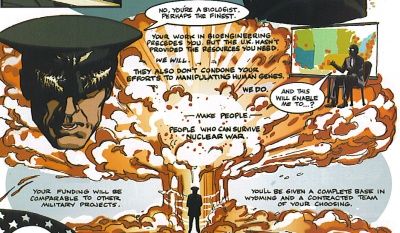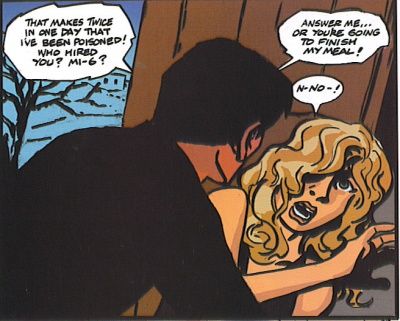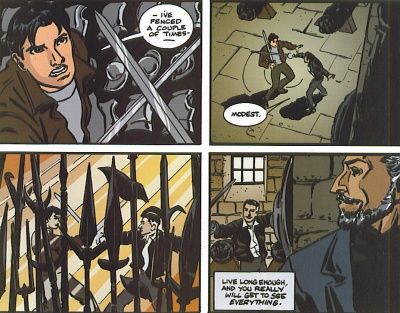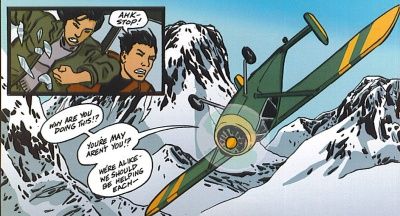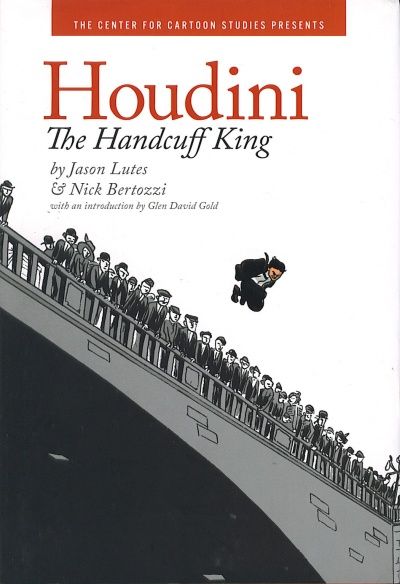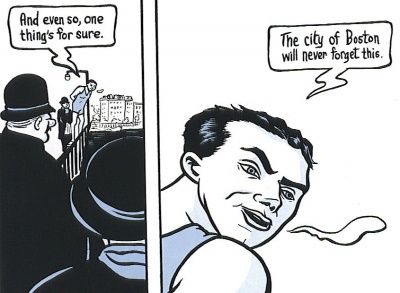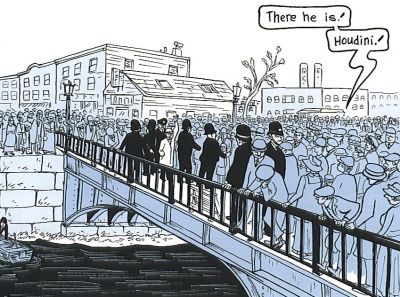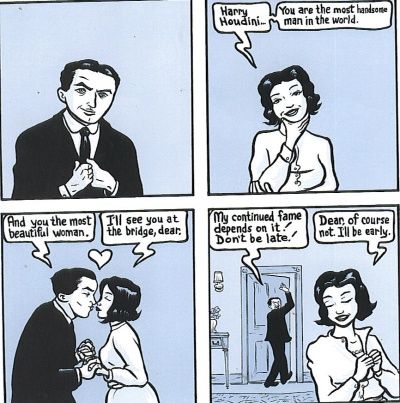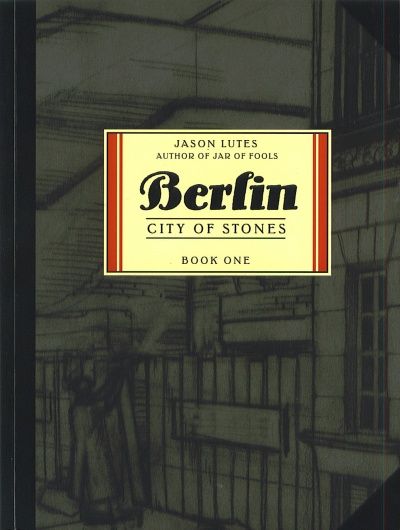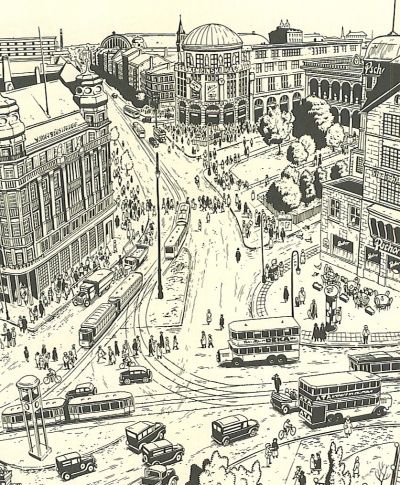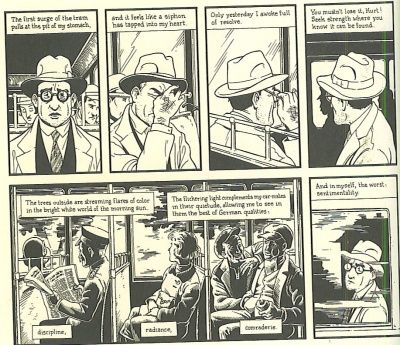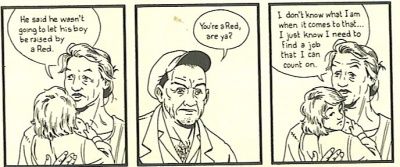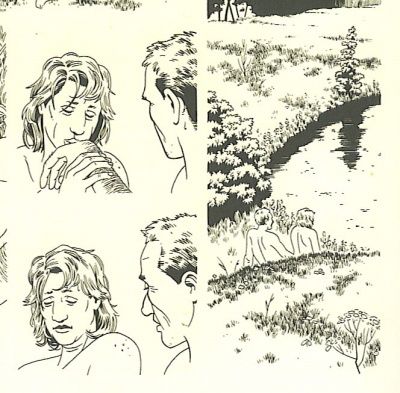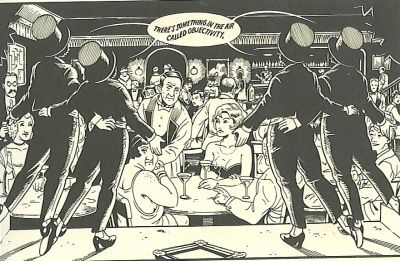Yes, it's time to check out some of those long-form comics you've been hearing so much about. I have a good feeling about their potential! Plus, there's a special Jason Lutes section to this post! How can you resist?
But first, let's check out some recent books, as in "from 2007." I didn't read these until 2008, but luckily, neither of these would have been in my top five. The first one, however, would have just missed. It's Midnight Sun by Ben Towle. It's published by SLG and costs $14.95. It's quite excellent.
Towle originally put out three issues of this, then decided to simply publish it as a graphic novel, a decision I heartily endorsed. Back in July 2006, when the first issue came out, I was less than enthused by it, not because I wasn't intrigued by the plot (a blimp flying to the North Pole crashes and a reporter is sent to get the story) but because the first issue moved so very slowly. I wrote: "I have a feeling that this will be something very interesting when it all comes together, which makes me think it should have been a graphic novel, because then I could have forgiven the slow start." And lo! it was interesting, and the resulting graphic novel is very good.
Towle tells the two parallel stories - one of the crew of the blimp, and the other of H. R., the reporter sent to cover the crash. This allows him, obviously, to bounce back and forth between the two and build some tension. The interesting thing about it, however, is that this isn't an exciting comic. The fate of the adventurers is in question, of course, but it's not like the danger they face - melting ice - is coming toward them with the speed of a runaway train, and fairly early on in the book, Towle lets us know that they'll probably make it back to civilization alive (but do they? that would be telling). Similarly, H. R. is never in any danger, and he doesn't attempt a bold rescue that puts him or anyone else at risk. He's there to report the story, and report it he does.
So what's the book about? Well, it's about men facing death and the choices they make, and it's about people understanding things about life that they might not have known before. When the blimp crashes, the captain is injured, so he's stuck. However, three crewmen decide to trek toward what they think is land. Later, a Swedish pilot arrives on the ice to rescue those left behind, but it doesn't go as well as planned. On the ship heading north, H. R. meets a Russian reporter, Zowie, whose fiance was on the blimp and whose fate remains unknown. Their relationship unfolds in a somewhat stereotypical way at first, with H. R. playing the obnoxious American and Zowie playing the angry Russian, but as they get to know each other, a respect builds and a quiet attraction. It's a mark of Towle's skills as a storyteller that he doesn't allow it to become a typical romance, as Zowie remains faithful to her missing lover, but we still feel the sparks between the two characters.
What's fascinating about this book is that so much is left unknown. People tell their stories about what happened, but they may be lying or have incomplete information. Ultimately, H. R. learns some lessons about himself and the way he's lived his life, but even that is implied more than stated. What makes the book so powerful is this vagueness, which, instead of angering us because there's not much of a resolution, makes us consider each character more and what they have learned. We each draw our own conclusions about the events on the ice, and it makes the ambiguity more interesting than if we had definitive answers.
I was a bit critical of the art in the first issue, but in later chapters it gets much better. When Zowie and H. R. have their one quiet moment, it's far less about what they say to each other than it is in how they look at each other, and Towle nails it beautifully. His flashback to the blimp's crash and the Swedish pilot's rescue attempts are also highlights, showing the limits of technology in 1928 very well.
As a serial, this comic was intriguing but not compelling enough to wait for. Now that it's in one volume, it's a very good book. I don't think it would have been in my Top Five for graphic novels, but it would have been in my Top Ten. If that's any kind of incentive to pick it up!
Another comic that came out in 2007 is decent but ultimately falls a bit short. It's called Therefore Repent! and is written by Jim Munroe with art by Salgood Sam. IDW published it, and it costs $14.99. It's certainly worth a look, even though I can't really get into the reasons why it fails too much because I don't want to spoil it. But I'll try!
The premise of the book is sheer genius: the Rapture has occurred, and the people left behind are trying to make their way the best they can. Yes, it's the premise of some apparently crappy Christian sci-fi novels, but that doesn't mean it can't work. Munroe starts the book post-Rapture, and looks at what happens to society when most of the best and brightest are gone. He takes some shots at the government - Bush, for instance, is still around, a bit grumpy because he didn't get "Raptured" - but for the most part, he keeps the focus local to show how the remaining people are adjusting to a more anarchic society, all the while dodging angels dressed as soldiers who drop down from the sky and occasionally shoot them. The main characters are a couple who call themselves Raven and Mummy. Raven wears a raven mask, while Mummy is often bandaged. They move into an apartment that the owners no longer need and become part of the neighborhood, where they begin to learn more about the Rapture and what it means. Magic is returning to the world, and they get caught up in it. Raven explains that they were at a music festival (hence the costumes) when the Rapture came. They were in their tent when Mummy started to rise. He grabbed onto Raven and wouldn't let go, because he wanted to stay with her rather than "go to his reward." They decided to wear the masks in order to remind people of what happened. But we soon learn it's far more than that.
As the two lovers get more involved in a resistance movement that's trying to fight back against the angels, they both go through some odd changes which leads to the very end of the book, which is where it kind of falls apart. It's a shame, because the relationship between Mummy and Raven is beautifully written throughout the comic, as we get a true sense of these people who wear literal masks and how figurative masks shape our lives. Raven and Mummy come to learn that we cannot hide from our true natures, no matter how much we try, and Munroe does a very nice job making this point without making it too obvious. It's not a revolutionary idea, to be sure, but when it's done well, it speaks to anyone who's ever interacted with other people. You know, like everyone. At its core, Therefore Repent! is a fine love story, and we don't get enough of those in comics.
It's almost enough to mitigate the ending, when we learn several things that make the comic far weaker. The resistance movement isn't a bad idea, nor are the gun-toting angels they fight - in fact, Munroe writes a couple of nice scenes that make the angels real characters, too. However, he doesn't go far enough with his premise. We learn a lot about the Rapture and the magic that is infusing the world, and it's unsatisfactory. It's not that it doesn't make sense - far from it. In the context of the book, it's not a bad explanation. But it makes the Rapture less ... interesting, I guess. I really can't say much without giving it away, but it kind of falls into the hoary old explanation about Hell - it's what we build ourselves. Sort of. Anyway, I always point to The Rapture, the brilliant 1991 movie starring Mimi Rogers and (briefly) David Duchovny, for an example of a religious movie that gets it right. Therefore Repent! comes close, but doesn't quite make it.
Salgood Sam's art is a big part of the comic's success. He has a very rough and detailed style that brings both the characters and their setting to life. We become totally immersed in the neighborhood where the story takes place, and even when it gets a bit metaphysical at the end, Sam keeps up with Munroe's art. He's called on the draw mundane details and esoteric wanderings, but it all looks good. When Mummy and Raven go on their spiritual journey to find the answers, he lightens up his lines and loosens things up a bit, giving the art a slightly ethereal feel. It's a nice book to look at, because it gives us such a good sense of place.
Despite the ending, which isn't bad but doesn't live up to the book's promise, this is an interesting look at a post-Rapture world and what the implications of it are. It's not offensive (I don't think) because it doesn't mock the idea of a Rapture and, despite the ending, doesn't claim the people who believe in it are wrong. Even if it doesn't come together perfectly, it's still a fascinating comic.
All righty, let's leave last year behind (at least for now - we'll be back!) and get in the Way Back Machine for ... 2006. Or 2004, depending on whether you want the U. S. publication date or the Japanese publication date. Wait, did I write "Japanese"? Why yes, I did! Does that mean Greg read even more manga? Why yes, it does! I know we now have our own manga expert blogging here, but there's no law that says I can't review some, is there?
A young lady at Atomic Comics in Mesa (that's her in the background looking grumpy, which may or may not have to do with the fact that she had to be in a picture with Jeph Loeb) has been bugging me to read more manga, so I took her advice and picked up The Kurosagi Corpse Delivery Service (volume 1) by Eiji Otsuka and Housui Yamazaki (translated by Toshifumi Yoshida). It's published by Dark Horse and will set you back $10.95.
Unlike the previous (and first, unless you count Akira) manga I read, this is more like what we think of when we think "manga." There are several volumes of the series, there's a precocious girl who's in college but looks about twelve, and there's a boy with hair that obscures his eyes. In addition to that, it's excellent.
Our story begins with Kuro Karatsu, a student at a Japanese Buddhist college. He's looking for a job to make ends meet, but he instead volunteers to go see dead people - a weird flyer asks for people to chant sutras in a forest. He meets the girl who put the group together - Ao Sasaki - and when he gets to the forest, he meets the others - Makoto Numata, a dowser who finds dead people instead of water; Keiko Makino, an embalmer, which is rare in Japan because cremation is the principal way of disposing of the dead; and Yuji Yata, who speaks to aliens through his hand puppet. Kuro displays an interesting ability of his own - he hears the voices of the dead. They're in the woods where an apparent suicide has been found, and the corpse tells Kuro that he wants to be buried with his girlfriend, Yuki, who died with him. Unfortunately for our heroes, Yuki's father is very rich and powerful, and he wasn't happy with Yuki's choice of boyfriend. The gang tracks Yuki and find out some horrible things about how and why she died. They solve the "case," and manage to get a winning lotto ticket for 3 million yen. Ao decides that they should help corpses their problems, and that the money should go toward founding the Kurosagi Corpse Delivery Service. And they're off!
The gang keeps coming across corpses with stories to tell, but the nice thing about the book is that it's not pure horror. The first story, "Less than Happy," certainly qualifies as horror, as does the third story, "Magician of Lost Love," but the other two aren't. Therefore, we're not bludgeoned over the head with horror plots, and the second and fourth stories give us a chance to catch our breath. It's a good thing, because the two horror stories are very creepy and disturbing, moreso because Otsuka and Yamakazi don't go for outlandish monsters - the monsters in the stories are all too real and, despite their maniacal behavior, familiar. Meanwhile, in "Lonely People," the second story, our heroes discover a corpse in a cabinet and try to find out exactly why the dead person was placed there. It's a sad story, to be sure, but only a "horror" one in that it shows some of the awful choices people are often forced to make. The fourth story, "September Rain," features what appear to be suspicious deaths, but it's much more complex - and interesting - than just someone murdering people. It's a very nice ironic story, in that the bad guy gets his comeuppance in a particularly poetic way.
The stories work well because the main characters, despite being underdeveloped in this particular volume (I've heard that changes in subsequent books), are very interesting and go about their business with great respect for the dead. The (living) characters who show up in the various stories are also excellent, because although many of them are awful people, we don't hate them completely. They're scary, yes, but they're also frightened, pathetic people, and it's an interesting feeling when they get what's coming to them - we relish their fates, but also pity them just a bit, because we don't think anyone should be subjected to what they go through. It's an interesting dichotomy.
I have bought volume 2 but haven't read it yet, but if it's anything like this one, I'm sure I'll enjoy it. This is a great idea for a book, and the execution is excellent. There's quite a bit of nudity, and none of it is really pleasant, if that bothers you. But if it doesn't, I recommend this highly.
Moving further back in the past, we find the first volume of the collected Scout, Tim Truman's old Eclipse series that has been published by Dynamite Entertainment and costs 20 dollars. Truman writes and illustrates, except for issue #7 (the final one in this book), which is drawn by Tom Yeates. So how is it?
It's quite good. The art is far superior to the writing, but the story is pretty fun. Truman sets the book in the future, meaning 1999, when the United States has fallen apart because of famine and the president has almost-dictatorial powers. Out of the wasteland of Arizona (now that's prescient!) rides Emanuel Santana, an Apache who is on a sacred mission to destroy four monsters before they destroy the world. Naturally, these monsters are pretending to be human, and they're all closely associated with the president. This brings Santana to Houston, where the president now lives, and into conflict with old allies from his days in a military training camp. He also meets up with a teenage runaway named Missy and the dregs of society in Houston, many of whom join his cause. Naturally, he goes up against the entire government, and things turn bloody very quickly.
The story is a blend of science fiction, Indian myth, action-adventure, and criticism of politics and the way it corrupts. It's entertaining, if not totally original, but Truman does some nice things with the characters that redeems the basic plot. Santana, for instance, remains an enigma throughout this volume, even though we learn a great deal about him. He is completely willing to sacrifice anyone to reach his goal (and does), and he wants no human connections whatsoever. We keep expecting romance to bloom between him and either the runaway, Missy, or a soldier he once loved, Rosa Winter, but Truman keeps undermining our expectations in that regard. Rosa and Missy, it turns out, become the most interesting characters, as Missy continually demonstrates an independent streak, while Rosa begins to question her devotion to the military when she's assigned to guard the vice-president and sees what's been done to her. By keeping Santana a mystery and developing the characters around him, Truman does a nice job keeping the tension of the book going while still giving us some substance to it.
I first saw Truman's art on Hawkworld, which was a few years after this, and it's strange how much better it is here. I like the art on Hawkworld, but it's a bit stiff. In Scout, it's much more fluid and detailed. Santana's fights with the monsters are wonderful to behold. The monsters take the form of various animals, from an owl to a buffalo, and Truman makes them truly frightening and of an earlier age of the world. He does a nice job with the other action, too, giving 1999 a clear apocalyptic feel without failing to show the society in which these people live. His page designs are very nice, too - he uses slanted gutters to dramatically break up the rectangular panels, he uses circular panels to rotate the action around a central figure, and he makes judicious use of splash pages. There's a roughness to Scout that much of his other stuff has lacked (even his work on GrimJack, which was earlier in his career), and I have to assume it's by design (or maybe because he inks it himself). It's fascinating to compare Truman's work with the other stuff - his work on GrimJack was as fluid as this, but much cleaner, while the art on Hawkworld is as rough as this, but stiffer. On Scout, he achieves the best of both worlds. Yeates, by the way, does a very nice job with issue #7, which is a particularly wordy story with a lot of small panels, but he handles it very well.
This came out in late 2006, and I believe I recently saw a second volume solicited in Previews. It's an exciting and beautifully drawn comic that, while it's not all that original, is well worth checking out.
So that's a 2006 book reprinting mid-1980s comics. Let's move to 2003 and check out The Interman, an espionage book written and drawn by Internet darling Jeff Parker. Yeah, Jeff Parker draws too. Doesn't that make you love him more? Octopus published this bad bear, and it also costs 20 dollars. (Amusingly enough, it has a glowing pull quote by Micah Wright on the back. I wonder if that's a good thing or a bad thing these days.)
The Interman is quite a blast, even though I am biased toward espionage already, so I might not be the best person to ask. Parker, however, has come up with a nice idea, and the book gives us plenty of action and intrigue while still managing to get into the characters nicely. We meet Van Meach, the Interman himself, in rather unusual circumstances, swimming without breathing apparatus in the Bering Sea. We learn quickly that he can adapt to any environment, so the cold and lack of air don't bother him. He is a man who makes a living doing strange jobs that people would rather keep quiet, but we soon find out that he was created as part of a secret genetics program run by the Pentagon in the 1960s. They wanted to create soldiers who could change their DNA to adapt to any environment, but they only made one - Meach - before the operation was shut down because of increased attention to military matters by watchdogs due to Vietnam. Now, the United States, along with England, France, Germany, and Japan - countries who sent scientists to work on the project - want Meach shut down. Thus begins a worldwide race, as Meach tries to elude assassins sent after him while trying to discover his origins, which he has never know. Meanwhile, it seems the Russians have their own "Interwoman" named May. Of course, she must cross paths with Meach eventually!
It's a gripping read, because Parker keeps us guessing about everyone's motives. Early on, we meet an assassin named Outcault, who appears to have the best chance to kill Meach ... except he's there to study him and ultimately, teach him. Meach is easy to find, but assassins find that being adaptable means that it's almost impossible to kill him, and their methods become increasingly brutal. He and May end up in Bhutan, where Meach learns something horrible about her, but ultimately, they both end up at the Interman complex in Wyoming, where everything is hashed out. It's quite the page-turner.
Parker's art isn't great, but it's not bad, either. He certainly has a nice sense of the characters and he handles the wide variety of locations well, from the jungles of the Galapagos Islands to the Cyclades to Calcutta. His action sequences work very well, as Meach fights many different ways, using swords, martial arts, and good old American fisticuffs. It's never boring to look at, as he shifts panel sizes to increase the pace and gives us some nice hallucinatory flashbacks.
The writing is the strong suit, as Parker gives every character interesting motives that compel them forward and blends in some nice humor as well. Once he found his strong concept, it becomes about making the characters real, and he does a fine job with that. Meach is looking for who he is, but in many ways, so are Outcault and May. Spy books are fine places to investigate the idea of what makes people who they are, and Parker doesn't beat us over the head with it, but allows the characters to lead us forward. Even some of the minor characters, like Ti Ling, the martial arts expert Meach battles to a standstill, are more interesting than your run-of-the-mill assassin. This makes the stakes everyone is playing for a bit more interesting and makes us care more about Meach and his quest.
Apparently, The Interman has been optioned by Paramount for a movie. Good job, Jeff Parker! So get it now so you can tell your friends how cool you were, knowing about it before the movie comes out! (Of course, it was optioned five years ago, so it might be stuck in development hell, but still, you and I haven't had anything bought by a movie studio, have we?)
Next, we come to the special Jason Lutes section of the post. I know, you're almost too excited to continue. I'm going to start with a recent book and work backward to one of the best comics I've read in a while.
First is Houdini, the Handcuff King, which is written by Lutes and drawn by Nick Bertozzi. It was published in 2007 by the Center for Cartoon Studies, or maybe by Hyperion Books. Maybe one commissioned it and the other published it? Anyway, it costs 17 bucks, if you care about price.
This got some buzz in Top Ten lists from last year (if Dick ever gets around to collating his lists, maybe it will show up), but I can't really agree. It's a decent enough book, but it lacks drama. The entire book takes place on 1 May 1908 in Cambridge, Massachusetts. Harry Houdini is planning to jump off the Harvard Bridge while handcuffed in order to promote his latest tour stop. (I would say that it's right there on the cover, but that, ironically, is from a flashback in Philadelphia - but you get the general idea.) Lutes takes us through Houdini's preparations for the jump, the way he figured out how to pick locks, the circus atmosphere that surrounded his appearances, the lengths to which the press and his rivals would go to expose him, and most importantly, how crucial his wife, Bessie, was to his success. It's an interesting book, but it's more of a manual on how Houdini did what he did rather than any kind of powerful story. Lutes accomplished what he set out to do, I guess, but it's remarkably uninspired, especially when we're dealing with a character as inherently interesting as Harry Houdini.
Bertozzi's art gives it a very nice oldy-tyme feel, as the characters look like something out of an early-20th-century photograph. He does particularly well with Houdini and Bessie, showing us the occasional maniacal look in the escape artist's eyes when he thinks about a trick or his legacy, as well as the affection he had for his wife. The scenes where Harry is about to jump off the bridge and Bessie is trying to reach him to give him a good-luck kiss work nicely, as Bertozzi nails the individual characters in the crowd and shows how Houdini played to the gallery perfectly. Bertozzi, who last year also drew The Salon (which he also wrote), seems to "get" this period of history, so he's a fine choice to draw the book.
It's not a bad comic by any means. Lutes writes the characters very well, even minor ones, and the love story between the escapist and his wife is sweet, even though it's also very pragmatic. But the book is dry because Lutes cares only about introducing us to the way Houdini did his thing, and although that's fascinating, it's not enough. As a dissection of Houdini's methods, it's fine. As a story, it falls short. Luckily, our next book more than makes up for it.
That book is Berlin: City of Stones, which Lutes wrote and drew. It costs 20 dollars and is published by Drawn & Quarterly. It's a collection of the first eight issues of his ongoing series and the first part of a trilogy about the German capital in the years leading up to the Nazi takeover. Lutes has been doing this series since 1996, and the individual issues come out about as often as the government acts responsibly, so it's probably best to pick up the collected edition and hope Lutes finishes the entire series before the sun goes nova. And you should pick it up, because it's absolutely brilliant.
The first volume takes place between September 1928 and May Day 1929. We begin on a train, where Kurt Severing meets Marthe Müller, both of whom are traveling to Berlin. Kurt, a reporter, is headed home, while Marthe is coming from Köln (Cologne) to enroll in art school. It's a fascinating conversation, as we get a good sense of the two people. They go their separate ways when they reach the city, but they intersect each others' paths again, not surprisingly.
Once we reach Berlin, Lutes throws us into a beautiful but occasionally brutal melange of people and ideologies. The two main ideological groups are the Fascists and the Communists, and it's interesting how the specter of Hitler, even at this early time in his ascendance (he was still in Munich at this time), haunts the city. He's barely mentioned, but the weight of our knowledge about what happens in a few years hangs over the book. The main plot of the book deals, ironically enough, with a character we meet after our two leads - a woman named Gudrun, who leaves her husband and falls in with the Communists, who help her out with her children and who take her to the traditional march on 1 May - but the plot is somewhat incidental to the book. Lutes is not oblivious to the political currents swirling in the city, and, in fact, he incorporates them very well into the narrative. He looks back to November 1918, when the First World War ended and the Germans couldn't believe their military machine had lost, and he often shows us how the politics of the Weimar Republic - with President Hindenburg growing more ineffectual every year - helped shape the people's discontent. But that's not the overriding focus of the book.
What Lutes does brilliantly is show us dozens of characters struggling to survive in the city and how the politics of Berlin forge their perspectives. Kurt Severing, as a reporter, is a good character for Lutes to show us the many factions in the city, but he has also been greatly affected by both the war and its aftermath. Marthe, as the "country bumpkin" (Kurt dismisses Köln as a city early on in the book), is able to view Berlin with the amazement it deserves, while her art student friends are sophisticated and jaded. They care about the lower class, but they also view the struggles of the poor with some bemusement. Meanwhile, Gudrun and the people she meets are Communists out of sheer necessity - the government has done nothing for them, and they believe revolution is the only way to better themselves. But politics don't define each character - it's only a part of them. Lutes makes their lives fascinating; they discuss all sorts of topics, fall in and out of love, become contradictory messes, and basically act like people. Gudrun finds that not all Communists are noble servants of the people, while Marthe discovers the problems with friends who want to be more than friends. All of these human moments in the book make the grander themes seem more important, because we have been following the characters through their lives and we have gained an understanding of what makes them tick.
The art is quite wonderful as well. Lutes uses a clear line style, and his details are what make the book so beautiful and probably causes him to finish an issue every five years or so. The city is magnificent, from the beautiful buildings to the squalor of the slums, and although Lutes has many characters in the book, it's very rare that you don't know who's who. It does happen a few times, but it's a minor complaint. Lutes doesn't do many revolutionary things with the design of the book, but he does know when to change things up, as when he shows two characters in silhouette when they have an important moment or when Gudrun has a dream of her estranged husband and the panels melt away into an idyllic scene in a meadow. It's a beautiful and tragic moment, and Lutes allows the art to convey both emotions.
Despite the fact that this book leaves things open-ended, it's a story that can be read as a complete experience. Yes, we wonder about the fate of several characters (and one hopes Lutes will show us what happens to several of them in later volumes), but ultimately, it doesn't really matter. Within the context of these eight issues, we have love, hate, sex, tragedy, triumph, and the splendor of humanity. We may not know the final fate of Kurt or Marthe, for instance, but it's not completely necessary, because we have seen these people at their best and worst. More than a story, this is almost a documentary of life in Weimar Berlin, and as such, we care more about watching what happens to these people while the "camera" is on them than what happens to them in the future. I'm curious to see what happens, but it's also not that important.
I've barely scratched the surface of this comic (I haven't even mentioned the religious element), but that's okay. It's endlessly rewarding, and demands a great deal of time. It's certainly not a breezy read, but it is a completely absorbing one, and it's the kind of comic that draws you into the pages and never lets go. It's absolutely wonderful, and I would recommend you go buy it now.
Yes, right now! It's that good!
I apologize, as usual, for the length of these posts. I really do try to review longer books in fives, as five graphic novels to a post seems like a fine number. But then I don't get around to it, and then I get more comics (I already have a new bunch I haven't read yet!), and then the posts get longer and longer. I hope I haven't lost too many of you! Let's review really quickly:
Midnight Sun - An ambiguous tale of rescue that reveals a great deal about people under pressure. Very good.
Therefore Repent! - A tale of the post-Rapture period that is certainly interesting, but ultimately a bit disappointing.
The Kurosagi Corpse Delivery Service (volume 1) - Horror manga at its best. Very, very twisted, but very good. Volume 6 comes out this week, so you can catch up with all of them!
Scout volume 1 - Interesting if a bit standard post-Apocalyptic story, made better by Tim Truman's excellent art.
The Interman - Fascinating espionage book with a great hook and solid story and art.
Houdini, the Handcuff King - Interesting look at a Houdini stunt, but disappointing because of the lack of a true story.
Berlin: City of Stones - You mean you're still reading this instead of off buying Berlin? Sheesh. Okay, one more time - this is absolutely brilliant. Amazon has it for 14 bucks, for crying out loud!
Well, that's it for this time. You know I'll be back with more! You can't stop me!

